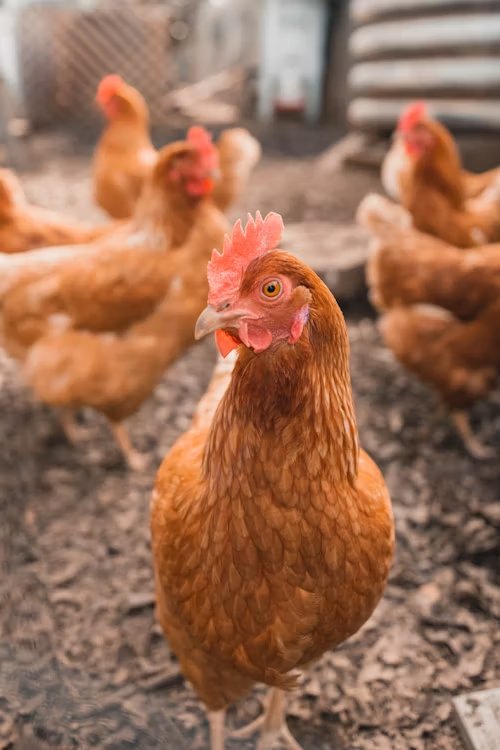Protect your flock from predators with these essential security measures and proactive strategies for your chicken coop.
One of the most heartbreaking experiences for backyard chicken keepers is losing birds to predators. Unfortunately, anything that keeps chickens in will eventually attract something trying to get in. Creating a secure environment for your flock isn't just about convenience—it's absolutely essential for their safety and your peace of mind.
Know Your Enemy: Common Chicken Predators
The first step in protecting your flock is understanding what you're up against. Different regions face different predator threats, but here are the most common culprits:
Ground Predators
Foxes, raccoons, dogs, coyotes, weasels, minks, opossums, rats, snakes
Aerial Predators
Hawks, owls, eagles, other large birds of prey
Digging Predators
Foxes, dogs, raccoons (will dig under fencing to access the coop)
Each predator has different hunting patterns and techniques. For example, raccoons are notorious for their dexterous paws that can open simple latches, while foxes often dig under fences to access their prey.

Essential Coop Security Features
A truly predator-proof coop needs multiple layers of protection:
Hardware Cloth vs. Chicken Wire
One of the biggest mistakes new chicken keepers make is relying on chicken wire for protection. Despite its name, chicken wire is designed to keep chickens in, not predators out.
- Hardware cloth: Use 1/2-inch galvanized hardware cloth (welded wire mesh) for all openings, windows, and ventilation areas. Smaller predators like weasels can squeeze through 1-inch openings, and raccoons can reach through larger gaps to grab chickens.
- Chicken wire: Appropriate only for non-security applications; raccoons and other predators can tear through it easily.
Secure Flooring
Many predators will attempt to dig under your coop or run:
- Extend hardware cloth at least 12 inches underground around the perimeter, then bend it outward at a 90-degree angle for another 8-12 inches to create an underground apron.
- Alternatively, create a solid concrete floor or place the coop on a concrete pad.
- For portable coops or tractors, attach hardware cloth to the bottom frame.
Predator-Proof Latches and Locks
Raccoons are surprisingly intelligent and can operate simple latches:
- Use two-step locks or latches that require opposable thumbs to open
- Carabiners work well when hooked through a hasp or around a latch
- Barrel bolts can be effective when properly installed
- Consider padlocks for additional security on main access doors
Overhead Protection
Aerial predators pose a significant threat to free-ranging chickens:
- Cover the entire run with hardware cloth, netting, or clear roofing material
- If complete coverage isn't feasible, provide multiple sheltered areas within the run
- For free-ranging situations, incorporate shrubs, bushes, or other cover where chickens can quickly hide

Nighttime Security Measures
Most predator attacks occur at night when chickens are most vulnerable:
Automatic Coop Door
An automatic chicken coop door is a worthwhile investment:
- Opens at dawn and closes at dusk automatically, eliminating the risk of forgetting to close the coop
- Available in solar-powered and battery-operated models
- Can be set on timers or light sensors to adjust with seasonal daylight changes
Proper Lighting
Strategic lighting can deter nocturnal predators:
- Motion-activated lights around the coop perimeter
- Solar-powered LED lights that create the impression of movement or vigilance
- Avoid constant bright lights that can disrupt your chickens' sleep cycle
Advanced Protection Strategies
Guardian Animals
For larger properties, consider guardian animals:
- Livestock guardian dogs: Breeds like Great Pyrenees, Anatolian Shepherds, or Maremmas bond with the flock and actively protect them
- Geese: Alert and aggressive toward intruders, they sound an alarm when predators approach
- Donkeys: Natural dislike of canines makes them effective guardians against dogs, coyotes, and foxes
Guardian animals require proper training and socialization with your chickens. Research specific breeds and their care requirements before adopting this strategy.
Deterrents and Repellents
While not foolproof on their own, these can add an extra layer of protection:
- Predator urine (commercially available) sprinkled around the perimeter
- Wind chimes or other noise-making devices that create unpredictable sounds
- Reflective tape or old CDs hung around the coop to create visual disturbances
- Motion-activated sprinklers that surprise approaching animals
Rotate these deterrents regularly, as predators will eventually become accustomed to them if they remain static.
Electric Fencing
An electric fence can be highly effective:
- Install a perimeter strand about 4-6 inches off the ground to deter digging predators
- Add additional strands at 12 and 24 inches to prevent climbing
- Modern solar chargers make installation relatively simple
- Low-amperage poultry-specific chargers provide enough deterrent without excessive cruelty
Regular Maintenance and Vigilance
Even the best predator-proofing requires ongoing attention:
- Inspect your coop and run weekly for signs of attempted entry or damage
- Check for holes, loose hardware cloth, or compromised locks
- Look for signs of digging around the perimeter
- Remove attractants like spilled feed or garbage that might draw predators to your property
- Consider installing a trail camera to identify what predators are active in your area
What To Do If You Experience a Predator Attack
If you do lose chickens to a predator, take immediate action:
- Examine the scene for clues about the type of predator (attack pattern, time of day, point of entry)
- Immediately reinforce security in the compromised area
- Consider temporarily adding additional protection measures until the permanent solution is implemented
- For persistent predator problems, contact your local wildlife management authority for guidance
Remember that in most areas, it's illegal to trap and relocate predators without proper permits, and many wildlife officials discourage relocation as it can spread disease and create problems in new areas.

Conclusion: Layers of Protection
The most effective predator-proofing strategy employs multiple layers of protection rather than relying on a single method. By combining physical barriers, deterrents, and vigilance, you create a system where if one layer fails, others are still in place to protect your flock.
Remember that predator-proofing is an ongoing process, not a one-time project. Adapt your strategies as you learn more about the specific challenges in your area, and don't get discouraged if you need to make improvements over time.
With proper planning and execution, you can create a secure environment where both you and your chickens can rest easy.



Comments (2)
Robert T.
June 12, 2023I lost three chickens last month to what I think was a fox. I've now implemented the hardware cloth buried around the perimeter and added two carabiners to my coop door. So far, so good! Thanks for the detailed advice.
Jennifer M.
June 15, 2023The automatic coop door has been a game-changer for us! No more rushing home at sunset to close the coop, and we haven't lost a chicken to predators since installing it. Well worth the investment!
Leave a Comment